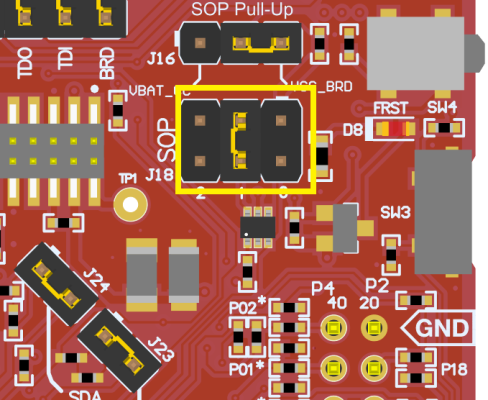SWRU548C February 2019 – September 2021 CC3235MODAS , CC3235MODASF , CC3235MODS , CC3235MODSF
- 1Introduction
-
2Hardware
- 2.1 Block Diagram
- 2.2
Hardware Features
- 2.2.1 Key Benefits
- 2.2.2 XDS110-Based Onboard Debug Probe
- 2.2.3 Debug Probe Connection: Isolation Jumper Block
- 2.2.4 Application (or "Backchannel") UART
- 2.2.5 JTAG Headers
- 2.2.6 Using the XDS110 Debug Probe with a Different Target
- 2.2.7 Power Connections
- 2.2.8 Reset Pullup Jumper
- 2.2.9 Clocking
- 2.2.10 I2C Connection
- 2.2.11 Sense on Power (SOP)
- 2.2.12 Push-Buttons and LED Indicators
- 2.3 Electrical Characteristics
- 2.4 Antenna Characteristics
- 2.5 BoosterPack Plug-in Module Pinout
- 3Layout Guidelines
- 4Operational Setup and Testing
- 5Development Environment Requirements
- 6Additional Resources
- 7Assembly Drawing and Schematics
2.2.11 Sense on Power (SOP)
The CC3235MODx device can be set to operate in four different modes based on the state of the sense on power (SOP) lines. The SOP lines are pins 23, 24, and 34 on the CC3235MODx module. Table 2-6 shows the state of the device and Figure 2-13 shows the SOP jumpers.
Table 2-6 SOP[2:0]
| Binary Value | Function |
|---|---|
| 100 | Flash programming |
| 000 | Functional mode and 4-wire JTAG |
| 001 | Functional mode and SWD |
| 010 | Functional mode and flash |
Note:
SOP[2:0] corresponds to J18 on the LaunchPad kit.
 Figure 2-13 SOP Jumpers (Default Setting Shown)
Figure 2-13 SOP Jumpers (Default Setting Shown)Note:
Placing no jumpers on the block ensures that the line is pulled low using 100K pull down resistors. Placing the jumper pulls the pin high using a 10K resistor.